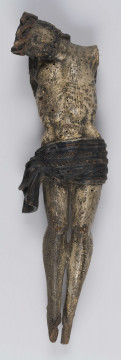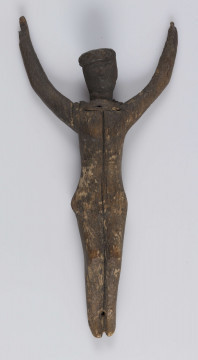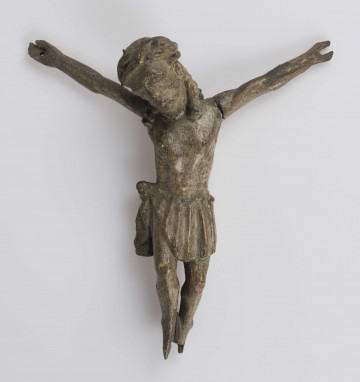
Christ Crucified
1801 — 1900
National Museum in Lublin
Part of the collection: Folk Art of the Lublin Region (17th–1st half of the 20th c.)
The Crucifixion is the climactic scene of the Passion of Christ, also known in 19th century Polish folk art. It is the theme most frequently depicted in Christian art since the 4th century. In the early period, Jesus' death on the cross was depicted symbolically, showing only the cross or the symbol of Jesus-the Lamb. It was not until the 6th century that the human figure of the Son of God appeared in paintings. The oldest surviving representation dates from the 6th century, and the iconographic pattern itself became established in the 13th century. Since then, its various variants have evolved, including narrative multi-figure depictions of Mary and St John or Mary Magdalene at the foot of the cross or, popular in Polish devotional art and found on roadside crosses, depictions of Christ Crucified with the insignia of the Passion, i.e. the instruments with which Roman soldiers inflicted pain and wounds on Jesus, as well as objects or items related to the Passion. These include: nails, crown of thorns, spear, Veronica's shawl, scourging column, silverware, rods (whips), pincers, hammer, dice, rooster, ladder, sponge, robe, sword.
Like the chapels with the Sorrowful One, crosses with the sculpture of Crucifixion are found in large numbers in the Polish landscape of villages and towns. They also belong to the basic equipment of churches - they welcome the faithful in the vestibule or decorate the rainbow beam joining the arcade arch situated on the border of the nave and the presbytery. Crosses densely fill the space of cemeteries, and in the form of little crosses they can be found in houses, nowadays usually above the door, once on the home altar or in a sacred corner. Figures of the Crucified Christ, like other folk Christological images, are characterised by great expressive power. They impress with their economical form and expressiveness achieved by simplification and geometrisation. Distortions and disorders of proportions, often unintentional and resulting from lack of workshop skills, add a special charm.
The preserved sculptures were made in wood, although in the museum collection there are also sculptures made in a less durable material - clay. Their creators were usually village carpenters and self-taught sculptors. There was also a group of itinerant carvers. Few names have survived: Paweł Bień, Mikołaj Gomieli, Jan Kaproń, Jan Oliński, Daniel Kuźmiuk or Józef Kwiatkowski.
Author / creator
Dimensions
cały obiekt: height: 34 cm
Object type
sculpture
Technique
sculpture
Material
wood
Creation time / dating
Creation / finding place
Owner
The National Museum in Lublin
Identification number
Location / status

1801 — 1900
National Museum in Lublin

1801 — 1900
National Museum in Lublin

1801 — 1900
National Museum in Lublin
DISCOVER this TOPIC
National Museum in Szczecin
DISCOVER this PATH
Educational path